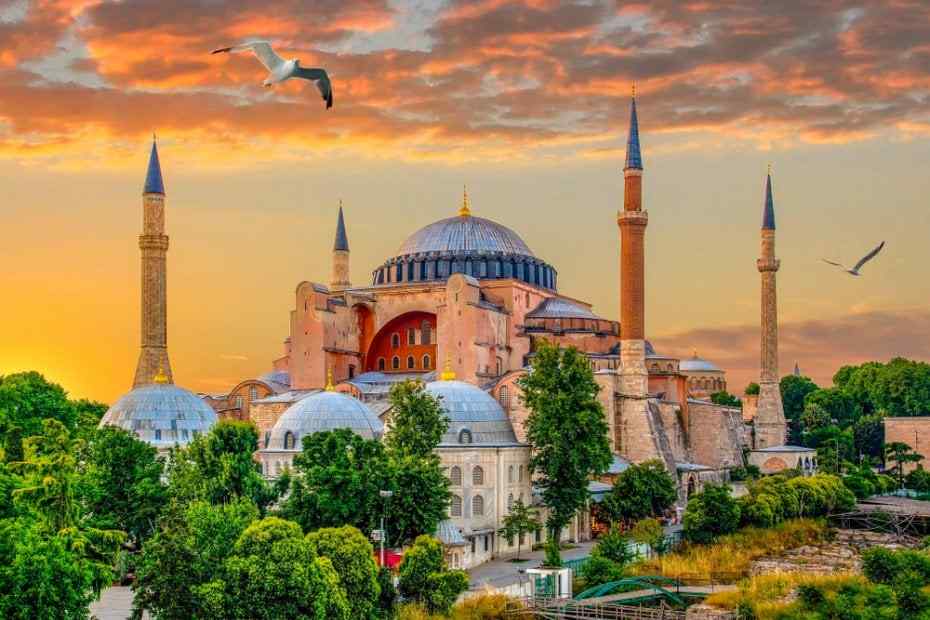The Hagia Sophia, where people are influenced throughout history by the glory of monarchs and cities, is considered one of the most important works in the history of world architecture by confronting collapses, fires, earthquakes and wars. Here is the story of Hagia Sophia, which has been standing since 537 and waiting for its guests…
The legendary story of the legendary city of Istanbul begins in the 4th century. The first Hagia Sophia was built during the reign of Constantine I (324-337), the sole ruler of a great empire from Scotland to the Red Sea, from Morocco to the Tigris and there are no remains today. Nevertheless, Megale Ekklesia stamped bricks found in the Museum store are thought to belong to this structure. The second Hagia Sophia was built during the reign of II. Theodosius. It’s designed with a basilica plan and wooden roof, the cathedral is burned in a rebellion. Today's Hagia Sophia was built by Emperor Justinyanus in the fifth year of his reign to build the most beautiful and most magnificent church in the empire, instead of the cathedral that was completely destroyed after the Nikea rebellion. The construction of today's Hagia Sophia begins in February 532.
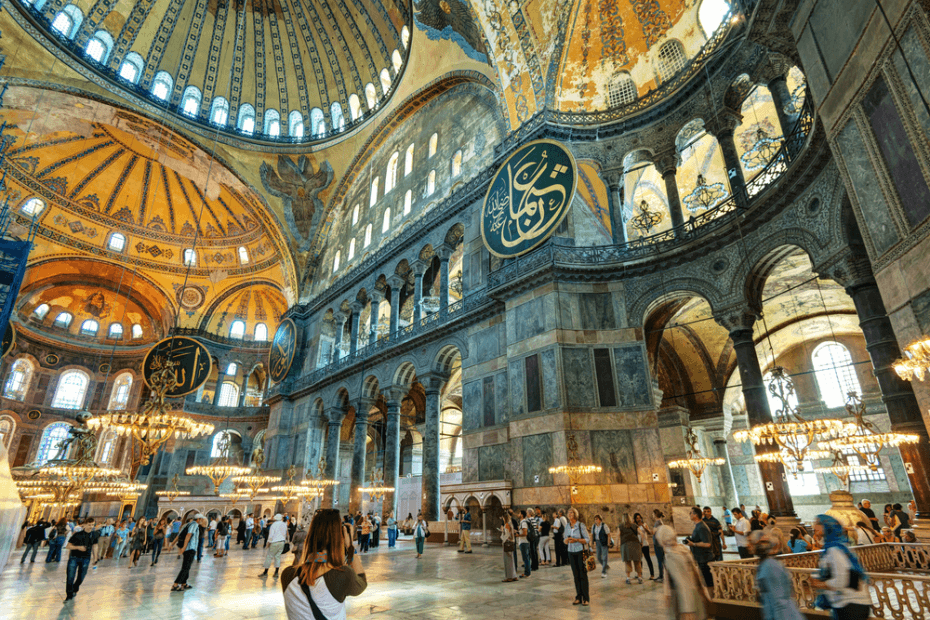
In Hagia Sophia an emperor wore the crown, a sultan read sermons, and a Byzantine baptismed. IV. For the commander of the Venetian Doju, Henricus Dandolo, who died in Istanbul at the age of 70 in 1205, the tomb became the tomb.
The open-air museum at the entrance of the Hagia Sophia, which reveals great respect for everyone and invites everyone under its own dome, contains historical monuments. These structures unearthed during the excavations in the western part of Hagia Sophia, It was built by II. Theodosius and represented the 12 Apostles of the second Hagia Sophia.
The last Hagia Sophia
Today's Hagia Sophia was designed by two masters of western Anatolia, the cathedral has record, which is the fastest built in the world, is completed in only 5 years. The building, where tens of thousands of people work in the construction, reflects the peace of being lost in the depths of history to its guests. The veined marbles on the walls are designed to soften the cumbersome structure of the interior. Every stone in Hagia Sophia has a story.
The building uses columns from the Temple of Artemis in Ephesus, the Temple of the Sun in Egypt, the Temple of Baalbek in Lebanon, and many more. It is still mysterious how these columns were moved with the facilities of the 6th century.
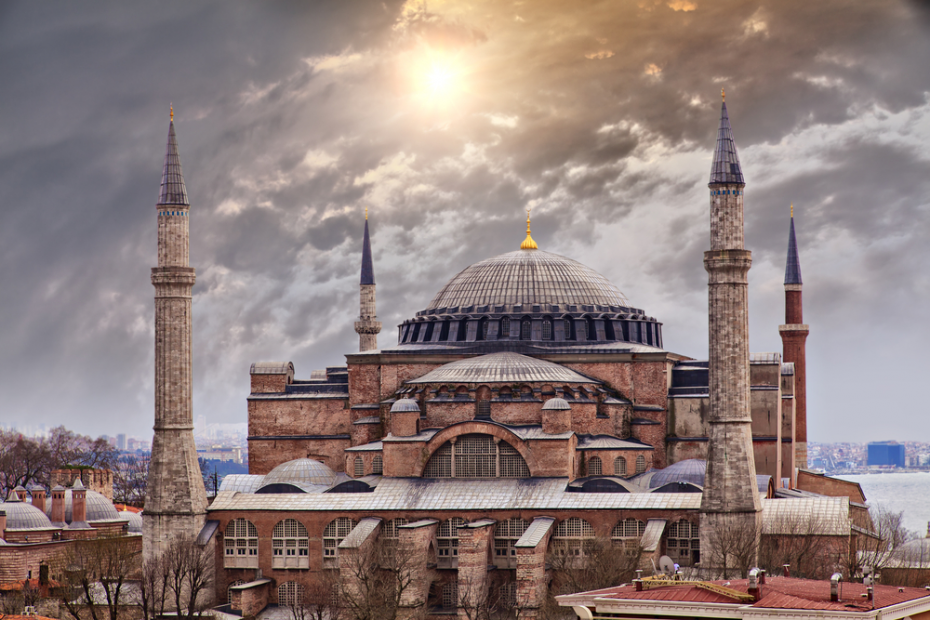
It is known that red porphyry which is used in covering and columns is originated from Egypt, green porphyry Greece, white marble Marmara Island, yellow stone Syria and black stone Istanbul and also made from stones from various parts of Anatolia. When the charming dome completed, it is interpreted as the symbol of the unrestricted universe.
In the time of the extremely large building can’t be completed all the deficiencies, 30 years after the opening of workmanship and decoration completed during the II. Justinyanus period. Water cisterns were placed under the Hagia Sophia as a precaution against the Earthquake. the dome collapses approximately 21 years after the opening because it does not fit statically when the building is over. The dome, which is 7 meters higher with lighter materials, reopens in 562 approximately 4,5 years after the repair. In this work, when there are deficiencies, supporting structures are added to the east and west facades of the building. The covering of the carrier big legs with colored stone slabs bears the traces of the understanding to conceal bulky-looking carriers. The console emphasizes the distinction of two floors and shows the motifs of the construction art of the early ages. The other feature in the upper floor gallery becomes prominent as tree tensioners between the arches. The 6th century’s motifs are handled to the visible face of these tensions.
The 4th Great Cathedral of the World
Hagia Sophia, the largest cathedral in the world for 900 years until the Cathedral of Seville, which was built in Spain in 1520, is now considered the 4th largest cathedral in the world.
The story of the Emperors, those who don’t want to be forgotten, those who dream of immortality, the traces and beliefs left behind by civilizations all hang on the walls of Hagia Sophia. Another fascinating aspect of Hagia Sophia is the mosaics. Stone pieces such as silver, colored glass, terracotta and colored marble are also used in the construction of the mosaics, which use tons of gold.
Emperor's Gate
In the middle of the mosaic above the gate of the emperor in Hagia Sophia, Jesus Christ sits. Jesus has Mary on the right and Gabriel on the left. There is a male figure with a beard depicted in the mosaic who is go down on knees at Jesus. This person was the Byzantine Emperor VI. Leonor is. According to the belief of the Orthodox sect a person can marry up to three times, VI. Because Leon doesn’t have a son in three marriages, he marries for the fourth time and takes part in the mosaic in the form of forgiveness. In the hands of Jesus, the words of the Gospel of John, ‘’Peace be upon you, I am the light of the universe’’is written.
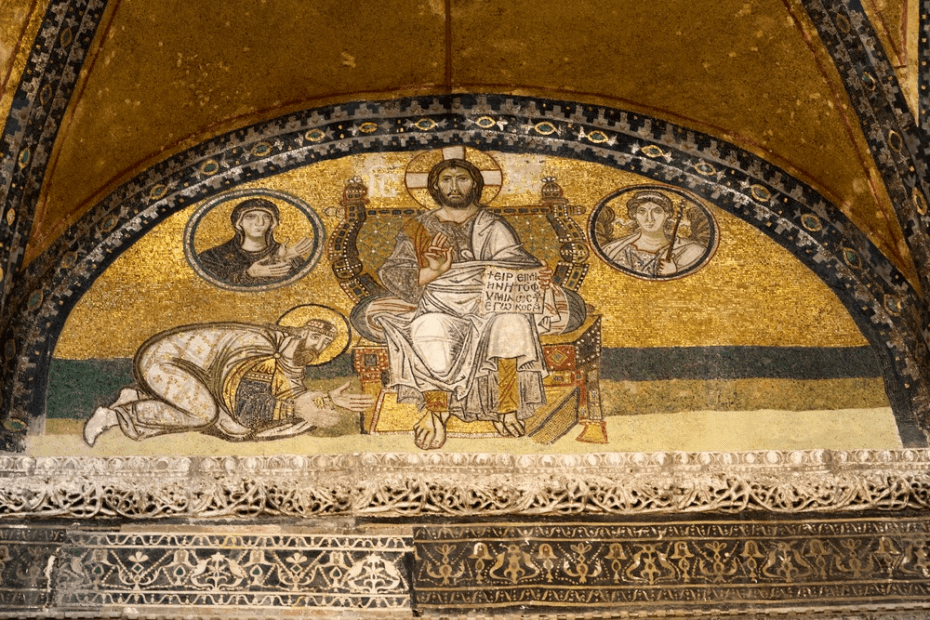
Deisis Mosaic in Hagia Sophia is considered one of the most important mosaic compositions. Here Mary and John the Baptist ask for help for humanity on the day of Judgment. The most important and striking feature of the mosaic is that the facial expressions on the right and left halves of Jesus are different. This mosaic is identified with Hagia Sophia and has become one of the most known and remembered mosaics in the world.
Family Mosaics
In the mosaic known as the Komnenos Mosaic, the panel depicts Emperor II. Ioannes Komnenos and his wife Eirene of Hungarian origin and their son II. Alexios located in. In the middle of the mosaic is the Virgin Mary and the baby Jesus figure in her arms. Jesus' right hand shows the sign of baptism, while the left hand holds holy verses. Another family mosaic in Hagia Sophia is the Zoe Mosaic. Mosaic panel, it has Emperor IX. Konstantinos Monomakhos and Empress Zoe. In this mosaic, there is Jesus in the middle, Jesus holds the Bible, the emperor has a gold pouch and the empress has a documentary depiction.
Virgin Mary and Jesus in her arms
The mosaic of the Virgin Mary and the baby Jesus in her lap is built in the 9th century. In this mosaic, the Virgin Mary is depicted sitting on a throne. When carefully examined, spades symbols appear on the cushions on the throne. It is known that gold was used in the mosaic to make the yellow parts of Jesus. Looking from below, the eyes of the Virgin Mary and Jesus are depicted with the angelic figure on the left cross garment. Silver is used for the white parts of the garment.
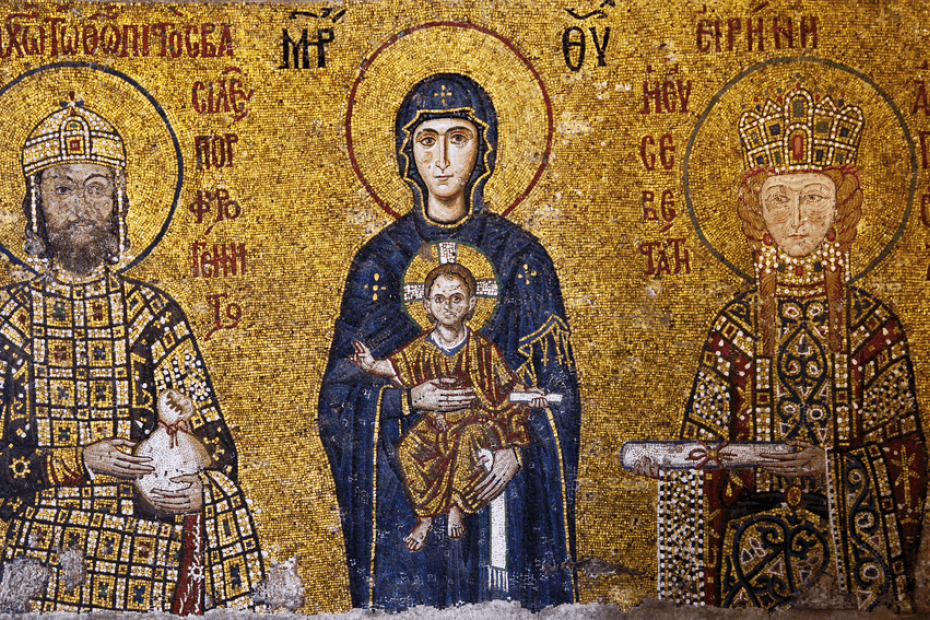
Hagia Sophia Mosaic of Existence
In the mosaic known as the Hagia Sophia Existence mosaic, the Virgin Mary in the middle, the baby Jesus in the lap of Mary, the Emperor Justinyanus to the right of the Virgin Mary and the Emperor Constantine the Great to the left. The construction date of the mosaic is known as the 10th century. Emperor Justinyanus, who built 3. Hagia Sophia, presents a model of Hagia Sophia in the mosaic. Emperor Constantine the Great, as the founder of Byzantine, presents a model of Constantine.
Folk Beliefs
As in most of the holy places, Hagia Sophia is subjected to various myths. For example, the Christian people, in 1453, the Ottoman Sultan of Istanbul II. Mehmet after his conquest to İstanbul, they believed that a priest had disappeared in the small chapel in the southern gallery and that he would reappear one day. Another such myth is related to the belief of the Muslim people. According to this belief, Khidr Prophet put his finger in the hole in the marble column in the northern gallery and turned Hagia Sophia towards the Kaaba. Hagia Sophia, which is influenced by all peoples, is known as the masterpiece of Byzantine architecture, but contains Pagan, Orthodox, Catholic and Islamic elements. For this reason, Hagia Sophia will always have guests.
Looting of Christians
Although this unique structure in Istanbul has seen many disasters throughout history, it has experienced an injustice that it doesn’t deserve. It is surprising that the destruction or looting of Hagia Sophia by human beings was carried out by Christians and not by other religions. IV. The Crusaders under the command of Venice Doju Commander Henricus Dandolo, who ruled the Crusade and died in Istanbul in 1205 at the age of 70, seized Istanbul and completely looted Hagia Sophia.
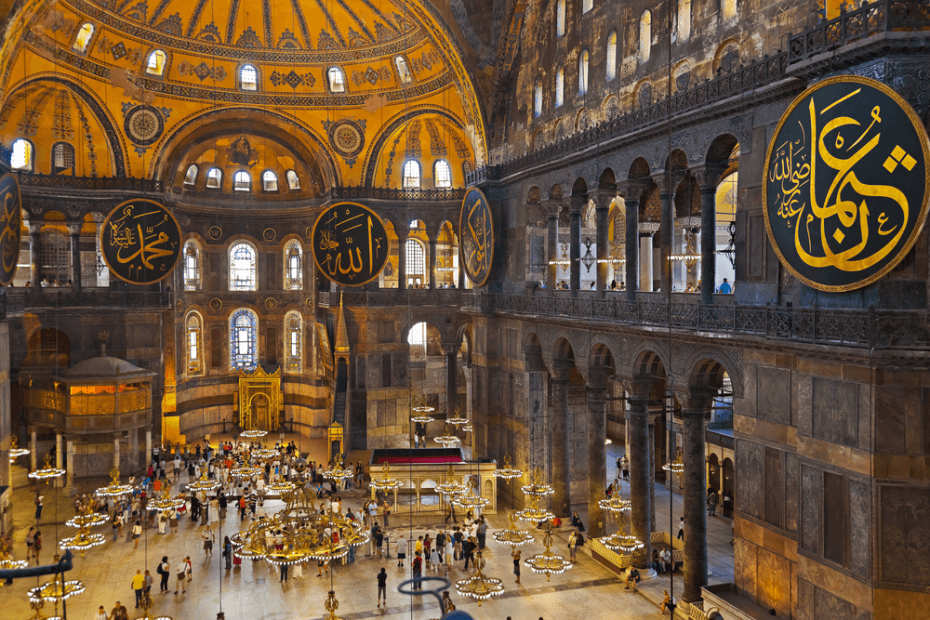
Ottoman Period
After the conquest of Istanbul in 1453 by the Fatih Sultan Mehmet in 1453, the Ottoman period began for Hagia Sophia, firstly measures were taken to keep Hagia Sophia alive and it was designed as a place for Muslims to worship. The first change in the period of Fatih begins and continues with the addition of a minaret. One of the most interested sultans of Hagia Sophia II. Selim and III. Murat were added by the chief architect Mimar Sinan during their periods, and the most important addition was the giant buttresses around it. These buttresses saved Hagia Sophia from collapse and reached to the present day. After the conquest of this place, which became the center of the Orthodox world and worshiped by Christians for 916 years, the period of the Mosque lasted 481 years. Hagia Sophia has been the pupil of the Ottoman Empire and the great mosque used by the sultans.
Turkey Period
After the church and mosque process of Hagia Sophia, which is very attractive in terms of culture, the museum period started from 1935 until today. Today, Hagia Sophia has opened its doors to all humanity for 1500 years as the world's longest worshiping place, it quietly watches the history that leaves its from around. In the same temple, two religions, four different minarets, two intertwined cultures and two civilizations took place as if calling out to the world, with its simplicity, its light, its mosaic and its dome continue to affects those who visit.
